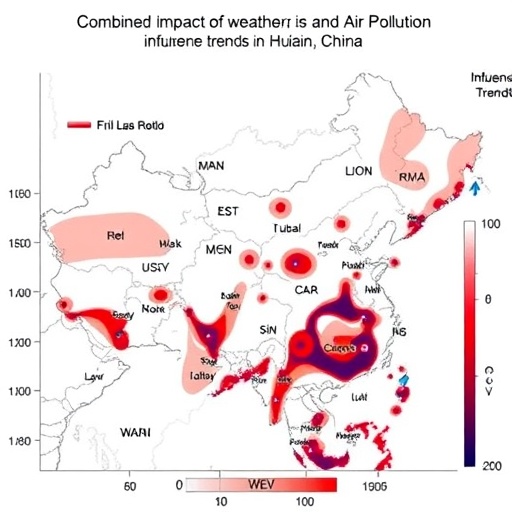A groundbreaking study recently published in Infectious Disease Modelling has shed new light on the intricate relationship between atmospheric conditions, air pollution, and the transmission dynamics of influenza in Huaian, China, from 2019 to 2022. Influenza, a viral respiratory illness with substantial global health implications, has long been recognized for its seasonality and contagiousness. However, this novel research highlights how the interplay of temperature, humidity, and pollutant levels can modulate both the risk and spread of the flu in complex, nonlinear ways.
The World Health Organization estimates that influenza affects approximately 5% to 10% of adults and 20% to 30% of children globally every year. Seasonal epidemics lead to millions of severe cases and hundreds of thousands of deaths annually, underscoring the critical need to understand environmental factors that govern viral propagation. Establishing connections between meteorological variables and air quality indicators offers essential insights into the timing and intensity of influenza outbreaks.
Researchers in this study utilized an advanced statistical framework known as the distributed lag nonlinear model (DLNM), which allows for the examination of both immediate and delayed effects of environmental exposures on health outcomes. Huaian was chosen as a representative site due to its unique climatic positioning between southern warm temperate and northern subtropical zones, housing a population exceeding 45 million. The investigation analyzed 9,205 influenza cases reported during the four-year period, alongside comprehensive meteorological and air pollution data sets.
One of the study’s most remarkable findings relates to the impact of fine particulate matter, PM2.5, on influenza risk. Intriguingly, low concentrations of PM2.5 — below 32 micrograms per cubic meter — showed a counterintuitive protective association, decreasing influenza risk by over 16%. Conversely, concentrations exceeding this threshold correlated with a roughly 16% increase in influenza cases. This nonlinear dose-response relationship suggests the presence of complex biological or environmental mediators, challenging prior assumptions that pollution uniformly exacerbates respiratory infections.
Temperature emerged as a critical modulator within the environmental matrix influencing influenza risk. The research demonstrated a significantly increased risk of flu infections during cooler temperature ranges, with risks rising by nearly 31% as temperatures declined within a specific window. This aligns with existing evidence that influenza viruses tend to be more stable and transmissible in colder climates, facilitating airborne survival and droplet persistence.
Moreover, when examining interaction effects, the study revealed that elevated temperatures could mitigate the adverse influence of high PM2.5 levels on influenza transmission. This interaction underscores the multifaceted nature of environmental determinants, where singular factors cannot be analyzed in isolation, but rather in their combined, context-dependent effects.
Humidity also plays an indispensable role in the epidemiology of influenza. The research highlighted that relative humidity below 40% during colder months augmented viral droplet survival and enhanced airborne transmission. This dry environment creates optimal conditions for viral particles to remain viable for longer durations, increasing the likelihood of infecting susceptible individuals.
Precipitation events were shown to contribute differently; rainfall tends to encourage indoor crowding, inadvertently supporting direct contact transmission routes. In such settings, people often congregate in enclosed spaces, heightening exposure through respiratory droplets and fomites. Therefore, rainfall indirectly potentiates influenza outbreaks by altering human behavioral patterns and exposure scenarios.
The study’s combined insights carry significant public health implications, particularly for forecasting influenza activity and implementing timely interventions. By quantifying the lagged impact of meteorological and pollution parameters, health authorities can develop predictive models to anticipate outbreaks, enabling preemptive measures such as optimized vaccination scheduling and strategic resource allocation within hospitals during high-risk periods.
Daihai He, the study’s corresponding author, emphasizes the practical applications of these findings: “Understanding the synergistic effects of environmental factors not only enriches epidemiological models but also empowers public health officials to formulate adaptive responses. This includes minimizing outdoor exposure during cold spells combined with elevated PM2.5 levels, as well as utilizing humidity and precipitation trends as early warning indicators.”
The study employed rigorous data collection and statistical analyses, encompassing a broad spectrum of variables: temperature, humidity, wind speed, atmospheric pressure, and diverse pollutants such as AQI, PM2.5, PM10, SO2, NO2, O3, and CO. Through this comprehensive approach, the researchers painted a nuanced picture of influenza dynamics shaped by a confluence of environmental determinants, transcending simplistic one-factor models.
It is worth noting the unique setting of Huaian, situated at a transitional climatic nexus, which renders it a fertile ground for such multifactorial investigations. Insights gleaned here could be extrapolated or adapted to inform influenza control strategies in other regions with similar climatic complexities and demographic profiles.
In conclusion, the intricate dance between air pollution, weather parameters, and influenza transmission revealed by this study carries profound implications for epidemiology and public health. By embracing the nonlinear and interactive nature of these factors, researchers and clinicians can enhance outbreak prediction accuracy and refine preventative strategies, ultimately mitigating the substantial burden of seasonal influenza worldwide.
Subject of Research: People
Article Title: (Not provided in the source)
News Publication Date: (Not provided in the source)
Web References: http://dx.doi.org/10.1016/j.idm.2025.07.010
References:
He, D., Cai, Y., et al. (2025). Interactive effects of meteorological factors and air pollutants on influenza: A case study in Huaian, China, 2019–2022. Infectious Disease Modelling. DOI: 10.1016/j.idm.2025.07.010
Image Credits: Yongli Cai, et al.
Keywords: Ecology, Microbiology, Pollution, Environmental remediation, Population biology, Environmental health, Epidemiology, Infectious diseases
Tags: advanced statistical models in epidemiologyair pollution effects on healthatmospheric conditions and infectious diseasesenvironmental factors affecting viral propagationHuaian climate and health studiesinfluenza transmission dynamicsnonlinear relationships in disease spreadpublic health implications of air qualityseasonal influenza outbreaks in Chinatemperature and humidity influence on fluweather impact on respiratory illnessesWHO influenza statistics and trends





